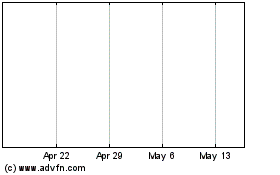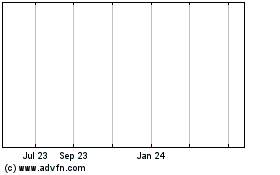Shell's Floating LNG Project Ships First Cargo
June 10 2019 - 9:14PM
Dow Jones News
By Robb M. Stewart
MELBOURNE, Australia--Royal Dutch Shell PLC's massive floating
gas factory off Australia's northwest coast, a multibillion dollar
engineering achievement years in the making, has shipped its first
cargo of liquefied natural gas.
Roughly the size of four soccer fields and displacing six times
as much water as the biggest aircraft carrier, Shell's Prelude has
sent its first tanker loaded with fuel to customers in Asia.
The shipment is an important milestone for the project, said
Maarten Wetselaar, Shell's director for integrated gas and new
energies. "Prelude forms an integral part of our global portfolio
and plays an important role in meeting the growing demand for more
and cleaner energy for our customers," he said.
Secured by mooring chains to the floor of the Indian Ocean
almost 300 miles off the remote town of Broome, the vessel has been
designed to operate in place for 25 years and withstand even the
fiercest storm.
Prelude is producing natural gas from a nearby field, bringing
it on board where it is chilled to a liquid for transport. The
floating facility is designed to produce 3.6 million metric tons a
year of LNG.
The facility began its journey from a South Korean shipyard in
mid-2017, pulled by tugboats to Australian waters where
pre-installed mooring chains were lifted from the seabed to anchor
the vessel.
While Shell hasn't publicly given a schedule or budget for the
project, it has been hit with delays and the company two years ago
had anticipated cash flows from Prelude would begin in 2018.
Production only got under way in late December, and the company
on Christmas day said its focus was on ensuring a controlled
environment for the project so it would operate reliably and
safely.
Big floating LNG platforms have long been viewed by energy
companies as a way of squeezing into a single facility the
processing, storing and offloading operations that sprawl onshore
so that they can be based over gas fields. That removes the need
for pipelines to land, dredging and other costly and often
disruptive work. Floating vessels can be moved to remote sources of
gas, worked for several years and then moved on to another isolated
field.
Yet despite being on the drawing board for decades, there are
few such vessels in operations.
Malaysian energy company Petroliam Nasional Bhd's Satu floating
LNG operation began production at the end of 2016, about a year
later than scheduled, and shipped its first cargo a few months
later. Early last year, Bermuda-based Golar LNG began production at
a FLNG platform in Cameroon. Other floating LNG vessels are
planned, including Eni's Coral FLNG project offshore Mozambique
that is slated to start up in 2022 with a 3.4 million ton a year
capacity.
Shell made the final investment decision to push ahead with
Prelude in May 2011, targeting the Prelude gas field and a resource
estimates at about 3 trillion cubic feet equivalent. Major
construction work on Prelude began in late 2012, with the cutting
of the first of more than 260,000 metric tons of steel for the
world's biggest floating LNG vessel, roughly 1,600 feet long and
weighing more than 600,000 tons.
Shell has said Prelude will be able to withstand the severest
cyclone. Ocean-going LNG carriers will load liquefied gas, chilled
to minus 260 Fahrenheit and shrunk in volume by 600 times, from the
floating facility for delivery to markets worldwide.
Write to Robb M. Stewart at robb.stewart@wsj.com
(END) Dow Jones Newswires
June 10, 2019 20:59 ET (00:59 GMT)
Copyright (c) 2019 Dow Jones & Company, Inc.
Shell (NYSE:RDSB)
Historical Stock Chart
From Mar 2024 to Apr 2024

Shell (NYSE:RDSB)
Historical Stock Chart
From Apr 2023 to Apr 2024
